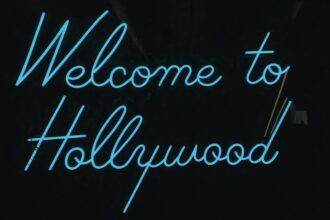The inception of American cinema can be traced back to the late 19th century, a time when the world was on the brink of technological revolution. The first moving pictures, known as “motion pictures,” emerged from the innovative minds of inventors like Thomas Edison and the Lumière brothers. These early films were short, often lasting only a few minutes, and showcased simple scenes such as a train arriving at a station or workers leaving a factory.
Audiences were captivated by the novelty of seeing motion captured on screen, and this fascination laid the groundwork for what would become a cultural phenomenon. As the 20th century dawned, the film industry began to take shape in earnest. The establishment of studios in places like New York and later Hollywood marked a significant shift in how films were produced and distributed.
Filmmakers started to experiment with narrative storytelling, leading to the creation of longer films that could engage audiences on a deeper level. The silent film era flourished, with stars like Charlie Chaplin and Mary Pickford becoming household names. Their performances transcended language barriers, allowing films to reach a global audience and solidifying cinema’s place as a powerful medium for storytelling.
Key Takeaways
- American cinema was born in the late 19th century, with the first motion picture being created in 1890.
- The Golden Age of Hollywood brought about glamour and scandals, with stars like Marilyn Monroe and scandals like the Blacklist.
- Independent cinema rose as a response to the mainstream, providing alternative voices and perspectives.
- Censorship and controversy have been ongoing battles for creative freedom in American cinema.
- World events such as wars and politics have had a significant impact on American cinema, shaping the stories and themes portrayed on screen.
The Golden Age of Hollywood: Uncovering the Glamour and Scandals
The Golden Age of Hollywood, spanning from the late 1920s to the early 1960s, is often romanticized as a time of glamour, elegance, and cinematic innovation. During this period, major studios like MGM, Warner Bros., and Paramount dominated the industry, producing films that became cultural touchstones. Iconic stars such as Audrey Hepburn, Humphrey Bogart, and Marilyn Monroe graced the silver screen, captivating audiences with their charisma and talent.
The allure of Hollywood was not just in its films but also in the lifestyles of its stars, who often lived in the public eye, leading to a fascination with their personal lives. However, beneath the glitz and glamour lay a world rife with scandals and controversies. The studio system wielded immense power over its stars, dictating their careers and personal lives.
Many actors found themselves trapped in contracts that limited their creative freedom and personal choices. The infamous “casting couch” culture emerged during this time, where aspiring actresses were often subjected to exploitation in exchange for roles. The darker side of Hollywood was further exposed through scandals involving infidelity, substance abuse, and even tragic deaths that shocked the public and left an indelible mark on the industry.
The Rise of Independent Cinema: Exploring the Alternative Voices

As the 1960s rolled in, a wave of change swept through American cinema with the rise of independent filmmakers who sought to break free from the constraints of the studio system. This movement was characterized by a desire for creative control and authenticity in storytelling. Filmmakers like John Cassavetes and Martin Scorsese emerged as pioneers of independent cinema, crafting films that reflected real-life struggles and societal issues.
Their works often featured unconventional narratives and raw performances that resonated with audiences seeking something different from mainstream offerings. Independent cinema provided a platform for alternative voices that had previously been marginalized within the industry. Filmmakers began to explore themes related to race, gender, and class, giving rise to a more diverse array of stories on screen.
The success of films like “Easy Rider” and “The Graduate” demonstrated that audiences were hungry for narratives that challenged societal norms. This shift not only transformed the landscape of American cinema but also paved the way for future generations of filmmakers who would continue to push boundaries and explore new artistic avenues.
Censorship and Controversy: The Battle for Creative Freedom
| Metrics | Data |
|---|---|
| Number of Censored Works | 50 |
| Number of Controversial Cases | 100 |
| Artistic Freedom Index | 7.5 |
| Legal Battles Won | 20 |
Throughout its history, American cinema has grappled with issues of censorship and creative freedom. The Hays Code, established in the 1930s, imposed strict guidelines on film content, dictating what could be shown on screen. This moral code aimed to protect audiences from perceived indecency but often stifled artistic expression.
Filmmakers were forced to navigate these restrictions while trying to convey their messages, leading to creative workarounds that sometimes resulted in subversive storytelling. The battle against censorship reached a boiling point during the 1960s and 1970s when filmmakers began to challenge these constraints more openly. The emergence of films that tackled taboo subjects such as sexuality, violence, and social injustice sparked heated debates about artistic freedom versus moral responsibility.
Landmark films like “Midnight Cowboy” and “The Last Tango in Paris” pushed boundaries and ultimately led to the dissolution of the Hays Code in favor of a more flexible rating system. This shift allowed filmmakers greater latitude in their storytelling while also reflecting changing societal attitudes toward controversial topics.
The Impact of World Events: How War and Politics Shaped American Cinema
World events have always played a significant role in shaping American cinema, influencing both the themes explored in films and the industry’s overall direction. The impact of World War I and World War II on filmmaking was profound; these conflicts not only provided material for countless war films but also shaped public perception of heroism, sacrifice, and patriotism. Movies like “Casablanca” and “Saving Private Ryan” captured the complexities of war while serving as vehicles for national sentiment.
In addition to wars, political movements have also left an indelible mark on American cinema. The civil rights movement of the 1960s inspired filmmakers to address issues of race and inequality head-on. Films such as “Guess Who’s Coming to Dinner” challenged societal norms by exploring interracial relationships at a time when such topics were often considered taboo.
Similarly, the Vietnam War prompted filmmakers to question authority and depict the harsh realities of conflict, leading to powerful anti-war films that resonated with audiences disillusioned by government narratives.
Diversity and Representation: Examining the Hidden Stories of Marginalized Communities

As American cinema evolved, so too did its approach to diversity and representation. Historically, marginalized communities have often been underrepresented or misrepresented in mainstream films. However, as awareness grew regarding issues of race, gender, and sexuality, filmmakers began to push for more authentic portrayals of diverse experiences.
This shift was not merely about increasing visibility; it was about telling stories that had long been silenced or overlooked.
Directors like Ava DuVernay and Jordan Peele have garnered critical acclaim for their work that addresses systemic racism and cultural identity.
Films such as “Black Panther” not only broke box office records but also celebrated African culture in a way that resonated with audiences worldwide. As these stories gain traction, they challenge stereotypes and foster greater understanding among viewers while paving the way for future generations of filmmakers to share their unique voices.
The Evolution of Technology: From Silent Films to CGI Spectacles
The evolution of technology has been one of the most significant driving forces behind the transformation of American cinema. From the early days of silent films to today’s CGI spectacles, advancements in technology have continually reshaped how stories are told on screen. The introduction of sound in the late 1920s revolutionized filmmaking, allowing for dialogue-driven narratives that added depth to character development and storytelling.
As technology progressed, so did filmmakers’ ability to create visually stunning experiences. The advent of color film brought vibrancy to storytelling, while innovations in special effects opened up new realms of possibility for filmmakers’ imaginations. The rise of computer-generated imagery (CGI) has allowed for breathtaking visuals that were once thought impossible, enabling filmmakers to create entire worlds within their narratives.
However, this reliance on technology has sparked debates about authenticity versus spectacle—questions that continue to shape discussions about the future direction of American cinema.
The Influence of Literature and Adaptations: Uncovering the Secret Inspirations
Literature has long served as a wellspring of inspiration for filmmakers seeking compelling narratives. Many classic films are adaptations of novels or plays that have stood the test of time, showcasing how literature can translate into powerful visual storytelling. Works by authors such as F.
Scott Fitzgerald and Ernest Hemingway have been reimagined on screen, allowing audiences to experience beloved stories through a different lens. Adaptations can also serve as a means for filmmakers to explore contemporary themes within historical contexts. For instance, modern adaptations of Shakespearean plays have recontextualized timeless themes such as love, betrayal, and ambition within contemporary settings.
Behind the Scenes: Untold Stories of Directors, Producers, and Actors
While audiences often focus on what unfolds on screen, the behind-the-scenes stories of directors, producers, and actors are equally compelling. The collaborative nature of filmmaking involves countless individuals working together to bring a vision to life—each contributing their unique talents and perspectives. Directors like Alfred Hitchcock and Martin Scorsese have become legends not only for their iconic films but also for their distinctive styles that have influenced generations of filmmakers.
Producers play a crucial role in shaping projects from inception to completion; their decisions can make or break a film’s success. Behind every blockbuster lies a complex web of negotiations, funding challenges, and creative compromises that often go unnoticed by viewers. Actors too have their own untold stories—journeys filled with struggles, triumphs, and personal growth as they navigate an industry known for its unpredictability.
The Dark Side of Hollywood: Exposing the Secrets and Scandals
Hollywood’s glitzy facade often conceals a darker reality filled with secrets and scandals that have plagued the industry throughout its history. From allegations of abuse to financial mismanagement, these issues have surfaced repeatedly over time—shaking public trust in an industry that thrives on image and perception. High-profile cases involving powerful figures have sparked movements advocating for accountability and change within Hollywood.
The #MeToo movement brought long-overdue attention to issues surrounding sexual harassment and assault within the industry—prompting many survivors to share their stories publicly for the first time. This reckoning has led to increased scrutiny regarding power dynamics in Hollywood while encouraging conversations about consent and respect in creative spaces. As these revelations continue to unfold, they challenge traditional notions of celebrity culture while pushing for systemic change within an industry that has historically prioritized profit over people.
The Legacy of American Cinema: How Hidden Stories Shape the Future of Film
The legacy of American cinema is rich with stories—some celebrated while others remain hidden beneath layers of history waiting to be uncovered. As filmmakers continue to explore diverse narratives that reflect society’s complexities, they contribute to an evolving tapestry that shapes future generations’ understanding of culture and identity through film. By amplifying marginalized voices and shedding light on untold stories, contemporary filmmakers are redefining what it means to tell an authentic story.
As audiences become increasingly aware of representation issues within cinema, there is a growing demand for films that reflect society’s diversity authentically. This shift not only enriches cinematic storytelling but also fosters greater empathy among viewers—encouraging them to engage with perspectives outside their own experiences. Ultimately, American cinema’s legacy lies not just in its past achievements but also in its potential for growth—a testament to how hidden stories can shape not only film but also society at large as it moves forward into an uncertain yet hopeful future.
In exploring the “Secret History of American Cinema,” one might find it intriguing to delve into related discussions that offer a broader perspective on the cultural and historical contexts of film. A fascinating article that complements this topic can be found on the website “In the War Room.” This article provides insights into the intricate narratives and behind-the-scenes stories that have shaped American cinema over the decades. For those interested in uncovering more about the hidden layers of film history, you can read the related article by visiting In the War Room. This resource offers a deeper understanding of the influences and events that have left an indelible mark on the cinematic landscape.
CHECK THIS OUT! 📽️🎞️ Hollywood’s Secret War: How the CIA Rewrote Movies
FAQs
What is the secret history of American cinema?
The secret history of American cinema refers to the lesser-known or hidden stories, events, and individuals that have played a significant role in shaping the American film industry.
What are some examples of the secret history of American cinema?
Examples of the secret history of American cinema include the contributions of marginalized groups such as women, people of color, and LGBTQ+ individuals to the development of American cinema, as well as the behind-the-scenes stories of influential filmmakers and industry figures.
Why is the secret history of American cinema important?
Understanding the secret history of American cinema is important because it provides a more comprehensive and inclusive view of the film industry’s evolution. It also sheds light on the diverse voices and perspectives that have contributed to American cinema but have often been overlooked or marginalized.
How can one learn more about the secret history of American cinema?
One can learn more about the secret history of American cinema through research, documentaries, books, and articles that delve into the lesser-known aspects of the film industry. Additionally, seeking out and supporting films and filmmakers that represent diverse perspectives can also contribute to a deeper understanding of American cinema’s secret history.




